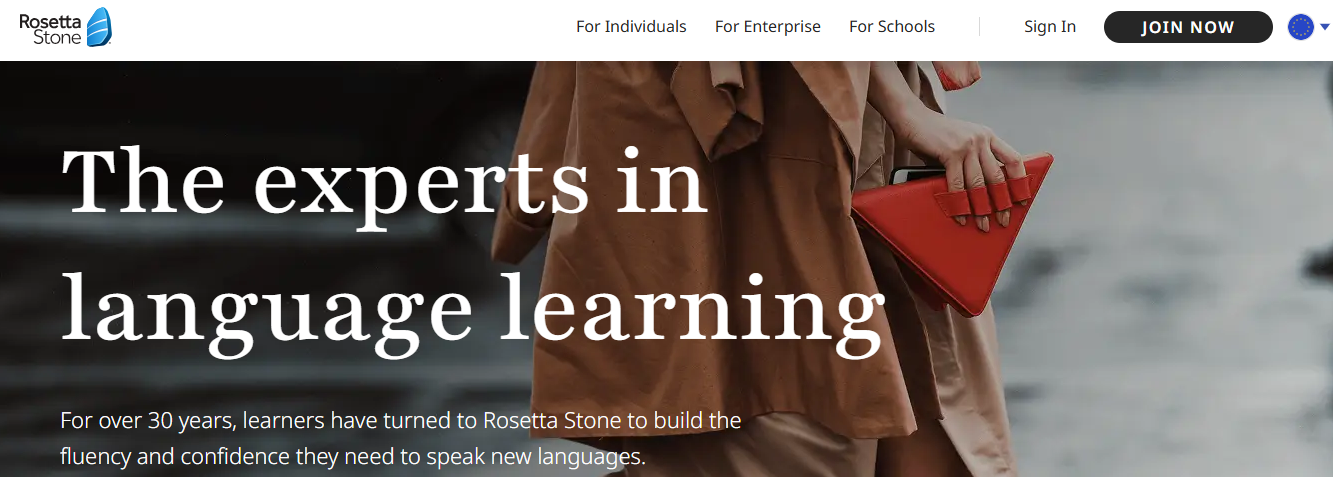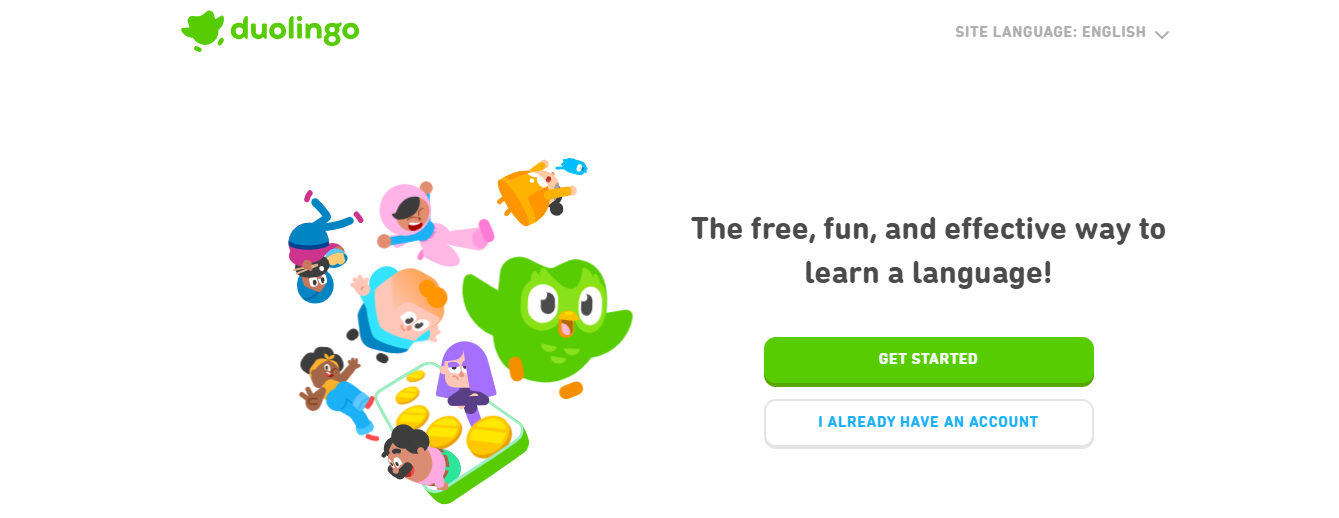Rosetta Stone vs Duolingo (Which Language App Should You Choose?)

Michael Xing, Founder of Pingo AI
You need to learn a language for travel, work, or just for fun, but the choices can feel overwhelming. Among top language learning apps, Rosetta Stone and Duolingo often rise to the top with very different approaches. Rosetta Stone leans on immersion and pronunciation practice while Duolingo uses gamified lessons, bite-sized drills, flashcards, and spaced repetition for vocabulary and grammar. This article breaks down features like speech recognition, progress tracking, available languages, pricing, and learning styles so you can figure out which app fits your goals and routine.
If you want a quick way to test what works for you, the Pingo AI language learning app provides short speaking practice, tailored feedback, and a simple plan, allowing you to compare how Rosetta Stone and Duolingo match your needs.
Rosetta Stone vs Duolingo at a Glance

Rosetta Stone uses a complete immersion method. All instructions and exercises appear in the target language, and the app trains users to associate images with words and phrases. Lessons emphasize listening and speaking, allowing users to build context and intuition without translation.
Duolingo follows a gamified model. It breaks the study into short, focused drills and uses points, streaks, and levels to keep users returning to the app.
Lesson Structure and Curriculum Flow
Rosetta Stone builds a linear path that gradually repeats concepts and increases complexity. Each lesson focuses on a limited set of vocabulary and contextual practice to reinforce recall.
Duolingo presents a branching skill tree with many short exercises that mix translation, fill-in-the-blank, listening, and speaking prompts. Duolingo layers vocabulary and grammar across themes, which helps with quick practice sessions.
Speaking Practice and Pronunciation Tools
Rosetta Stone’s TruAccent speech recognition provides detailed feedback on pronunciation and encourages spoken responses in real time. The system compares your pronunciation to native speakers and pushes you to match intonation and rhythm.
Duolingo includes microphone exercises and speaking prompts, but its feedback is lighter and often binary, like correct or incorrect. If focused speaking practice is your priority, TruAccent gives more precise guidance.
Grammar, Vocabulary, and Memory Techniques
Rosetta Stone teaches grammar implicitly through repetition and context, so learners internalize structure without formal rules. Duolingo mixes implicit learning with explicit grammar notes in some languages and uses spaced repetition to resurface words. Both platforms build vocabulary, but Duolingo’s frequent short reviews help retention when you practice daily.
User Experience, Motivation, and Community Features
Rosetta Stone keeps a calm, distraction-free interface aimed at steady progress. The pacing expects longer sessions and attention to accuracy. Duolingo uses bright visuals, achievements, leaderboards, and social features to drive habit formation and frequent micro sessions.
Platform Availability and Offline Use
Both apps run on iOS and Android and offer web versions for desktop study. Rosetta Stone allows lesson downloads for offline learning within the app. Duolingo also supports offline lessons for subscribers and syncs progress across devices for continuity when you move between phone and computer.
Pricing Options and Access Models
Duolingo provides a free tier with ads and an optional paid subscription for ad-free learning and extra features. Rosetta Stone relies on subscription plans and sometimes offers a lifetime purchase option for a language, as well as classroom and enterprise licensing. Schools and families can find separate plans on both platforms, so consider how many users and what features you need.
Which App Suits Each Best
Choose Rosetta Stone if you want immersive lessons, rigorous pronunciation coaching, and a structured curriculum. Choose Duolingo if you prefer short, gamified sessions, strong habit incentives, and a free entry point.
Related Reading
- Top Language Learning Apps
- Babbel vs Duolingo
- How Much Is Duolingo Max
- How Much Does Babbel Cost
- Best Apps to Learn Spanish
- Best Apps to Learn Japanese
- Busuu vs Duolingo
- Duolingo Alternatives
How Does Rosetta Stone Work?

Rosetta Stone uses a method called Dynamic Immersion to teach languages the way children learn their first tongue. Lessons present pictures, sounds, and written words in the target language so your brain links meaning to forms without relying on English translation. Units are built around real-life situations like travel, shopping, and health, and each unit combines core lessons with focused practice in vocabulary, pronunciation, and grammar.
How Lessons Are Structured and Paced
Lessons move from simple recognition to active production. You start by matching images to spoken phrases, then repeat and record speech, and later choose the correct response in short dialogues.
The program layers vocabulary and grammar across units so you see words used in multiple contexts rather than isolated lists. Progression is linear but flexible; you can repeat drills and review vocabulary as needed.
How Pronunciation Practice Actually Works
Rosetta Stone uses TruAccent speech recognition to listen to your voice, score your pronunciation, and give instant corrective feedback. Exercises break words down into sounds and syllables so you build correct articulation before speaking complete phrases. You can record a line, listen to a native speaker, and compare waveforms and timing to refine rhythm and intonation.
How It Handles Reading, Listening, and Speaking
Audio recordings are clear and intentionally paced to help comprehension. Reading exercises range from simple labels to longer Stories that combine listening and reading with optional voice recording. There are audio-only lessons you can download for offline practice, which support repetition during commutes or workouts.
How Rosetta Stone Adds Human Interaction
The platform offers live lessons and small group coaching led by native speakers. These sessions let you practice conversation, get cultural context, and receive real-time corrections beyond automated feedback. The live format bridges self-study and real-world speaking, making classroom-style dialogue available on demand.
How Rosetta Stone Compares With Duolingo and Other Apps
If you compare Rosetta Stone vs Duolingo, you’ll see different philosophies. Duolingo emphasizes gamification, bite-sized lessons, streaks, and quick daily practice with translation prompts and engineered incentives. Rosetta Stone focuses on immersion, fewer distractions, and pronunciation depth.
Duolingo often uses spaced repetition for vocabulary and a free tier that hooks users with game mechanics. Rosetta Stone leans on paid subscriptions, structured levels, and intensive pronunciation work. Which is better depends on goals. Quick vocabulary building and habit formation often suit Duolingo, while deep spoken accuracy and translation-free immersion favor Rosetta Stone.
What the Tech and Content Choices Mean for Learners
Speech recognition, native speaker recordings, and consistent immersion create stronger pronunciation and listening skills over time. The lack of English translation forces contextual learning, which can slow early progress but builds more natural comprehension.
If you need fast survival phrases for travel, a mix of apps might work better. If your aim is clear spoken output and accent improvement, the focused pronunciation drills and Stories add measurable value.
Practical Tips for Using Rosetta Stone Effectively
Use the recording and compare feature regularly to track subtle improvements. Combine core lessons with live coaching to practice unstructured conversation. Download audio lessons for repetition away from the screen. Pair Rosetta Stone with a gamified app if you want more daily reminders and vocabulary review.
Pingo AI: Speak Confidently, Learn Naturally
Pingo's AI language learning app focuses on conversation first practice, powered by expressive AI, so you practice real-world dialogues instead of memorizing flashcards. With adaptive feedback, personalized exercises, and two modes for beginners and advanced learners, Pingo helps you build speaking confidence fast. Try it free today to start talking.
How Does Duolingo Work?

Duolingo breaks language learning into short, focused exercises you can finish in five to ten minutes. Each lesson mixes reading, listening, speaking, and typing tasks. The app shows you a sentence or image, asks you to match or translate, and uses speech recognition for spoken responses. You get instant feedback on errors so you can correct pronunciation and grammar as you go.
Free Access Versus Super Duolingo Features
The base app is free and supported by ads. You earn experience points and maintain streaks without paying. Super Duolingo removes ads, gives unlimited hearts so mistakes do not block progress, lets you download lessons for offline use, and opens advanced practice modes like Legendary challenges and a Practice Hub focused on past errors.
How the Learning Tree and Lesson Flow Work
Languages are organized into a series of topics arranged as a learning tree. Each topic contains several lessons. Lessons have about ten to twelve micro tasks that repeat vocabulary and grammar with slight variations. Skills gain crowns as you repeat and master them. Reaching higher crown levels unlocks tougher practice and new topics.
Exercises, Speech Recognition, and Feedback
Expect translation, fill-in-the-blank, listen and select, picture match, and speak aloud tasks. The speech engine listens and flags clear pronunciation issues. You also hear native speaker voices and machine-generated prompts. This combination helps ear training and basic speaking, though complex conversation practice remains limited.
How Duolingo Keeps You Coming Back
The app uses gamification elements like XP, streaks, leagues, and virtual currencies to motivate daily practice. Hearts limit how many mistakes you make before you must review, unless you pay for unlimited hearts. Leaderboards and timed practice add competitive pressure for learners who respond well to goals and rewards.
Review System and Memory Reinforcement
Duolingo uses spaced repetition ideas to push items you miss and to surface weak skills in review sessions. The Practice button and periodic quizzes test retained vocabulary and grammar. The system adapts to mistakes, allowing you to see weaker items more often, but it will not replace targeted spaced repetition tools if you need deep retention.
Where Duolingo Excels and Where It Falls Short
Duolingo excels at rapid vocabulary building, consistent daily practice, and making learning feel low-friction. It works best for beginners and low intermediate learners.
The app provides limited grammar explanations and only offers simulated speaking practice. For real-world conversation and advanced grammar, pair Duolingo with conversation practice, textbooks, or courses that focus on structure and production.
How Duolingo Compares with Rosetta Stone in Practice
Duolingo favors game-driven, bite-sized lessons and free access. Rosetta Stone uses an immersive method that aims to teach without direct translation, relying heavily on native speaker audio and a TruAccent speech engine for pronunciation.
Rosetta Stone costs more and focuses on listening and speaking with fewer gamification features. Duolingo gives fast vocabulary gains and regular micro practice, while Rosetta Stone emphasizes immersion and pronunciation training.
What to Ask Yourself Before Choosing a Platform
- Do you need structured immersion and focused pronunciation work, or do you want free daily practice that builds vocabulary quickly?
- How much conversation practice will you add outside the app?
Your answers determine whether Duolingo, Rosetta Stone, or a mix best suits your goals.
Related Reading
- Memrise vs Duolingo
- Best Apps to Learn French
- Lingodeer vs Duolingo
- Pimsleur vs Babbel
- Jumpspeak vs Duolingo
- Best Apps to Learn Mandarin
- Best Apps to Learn Arabic
- Best Apps for Learning English
- Best Russian Learning Apps
Rosetta Stone vs Duolingo: Key Feature Comparison

Rosetta Stone uses complete immersion with lessons entirely in the target language, so learners build intuition and contextual understanding. Duolingo uses gamified microlearning with translation and matching exercises to build vocabulary quickly and maintain high engagement.
Lesson Length and Pacing
Rosetta Stone lessons run 10 to 30 minutes and follow a linear sequence of units and levels. Duolingo delivers short five-minute bursts and flexible practice that fits into pockets of free time.
Grammar Instruction
Rosetta Stone teaches grammar implicitly through repetition and context without explicit grammar rules. Duolingo mixes explicit grammar tips in selective lessons with lots of pattern practice.
Speaking and Pronunciation
Rosetta Stone provides detailed pronunciation feedback with its speech recognition engine, analyzing phonemes and syllables for accuracy. Duolingo offers voice exercises but gives simple pass fail checks rather than fine-grained corrections.
Content Depth and Progression
Rosetta Stone maps out a structured curriculum that emphasizes reading, listening, pronunciation, and progressive complexity. Duolingo layers skills in a tree and reinforces vocabulary through spaced practice and review.
Motivation and Habit Tools
Duolingo uses streaks, XP, badges, and leaderboards to drive daily use. Rosetta Stone emphasizes steady course progress, offers live tutoring sessions, and tracks mastery without heavy gamification.
Live Practice and Human Instruction
Rosetta Stone offers optional live tutoring and coaching to practice conversation and correct mistakes with a teacher. Duolingo supplements automated practice with AI roleplay in higher tiers but no regular human tutoring in base plans.
Offline and Mobile Use
Both provide mobile offline lessons; Rosetta Stone includes audio-only lessons for commutes and supports more audio-focused practice. Duolingo caches interactive lessons with limited functionality when offline.
Languages Available
Rosetta Stone covers about 25 modern languages with some less common options. Duolingo covers over 30 languages and includes experimental and fictional languages that attract niche learners.
How They Teach: Teaching Method and Learning Experience
Rosetta Stone immerses learners from the start, using images, audio, and text to build understanding without translation. Vocabulary and grammar develop naturally through repeated listening, speaking, and reading drills, reinforced by pronunciation feedback and story-based practice.
Duolingo delivers short, repeatable lessons with instant feedback and rewards that build daily study habits. Learners translate, speak, and match words through varied exercises, while spaced repetition reinforces memory. Premium features add AI-driven roleplay for conversational practice.
Languages, Tech, and Tools: Coverage, Pronunciation, and Platform Features
Rosetta Stone focuses on mainstream world languages plus a few less common choices and markets its product to learners seeking practical fluency. Duolingo expands reach by offering many more languages, including constructed languages and community-requested courses that reflect strong user-driven development. Which set matters depends on whether you need a high-quality course or a wide range of experimental options.
Pronunciation Technology and Speaking Practice
Rosetta Stone’s speech recognition provides detailed feedback that isolates pronunciation errors and guides correction at the syllable or sound level, supporting accent reduction and clearer speech. Duolingo’s voice checks confirm whether words were spoken but rarely grade precise pronunciation, leaving learners to refine accents through repetition and external practice.
Engagement Systems and Learning Science
Duolingo leverages gamification mechanics to maintain motivation with streaks, leaderboards and XP incentives and uses spaced repetition to revisit vocabulary. Rosetta Stone emphasizes immersive repetition and contextual drills that push learners to think in the language and correct via targeted feedback, with optional live lessons to test conversational skill with a coach.
Offline Access, Device Support, and User Interface
Both apps support offline work, with Rosetta Stone offering audio-only lessons for commuters and longer audio sessions that free learners from screen time.
Duolingo’s offline mode mirrors the app experience but restricts some features. Rosetta Stone presents a polished, calm interface aimed at adult learners, while Duolingo opts for a colorful, personality-driven design that suits rapid daily interaction.
Cost and Subscription Model: What You Pay and What You Get
Rosetta Stone offers subscription plans and a lifetime access option. Short-term plans cost a few dozen dollars, annual plans run in the low hundreds, and lifetime licenses are sold for a one-time fee. All subscriptions include access to every language, with live tutoring available at extra cost.
Duolingo’s free tier includes ads and limited lives but still offers solid learning value. Super Duolingo removes ads, adds unlimited hearts, and includes extra tools for a modest fee. Duolingo Max builds on this with AI features like Explain My Answer and Roleplay for advanced practice.
Strengths and Weaknesses: Pros and Cons Compared
Rosetta Stone strengths:
- Strong immersion that trains learners to think in the language and process meaning from context.
- Robust pronunciation feedback that helps correct accent and articulation.
- Structured, linear curriculum that suits learners aiming for deep study and progressive mastery.
- Optional live tutoring for human conversation practice and coaching.
Rosetta Stone weaknesses:
- Higher cost relative to many language apps and no free tier.
- A less gamified design that can feel slow for learners seeking instant rewards.
- Smaller catalog of languages than competitors, with fewer experimental or niche options.
Duolingo strengths:
- Free core experience with a full mobile app that supports daily habit building.
- Powerful gamification that motivates repeated short sessions through streaks and rewards.
- Wide language selection that includes both common and niche courses.
- Affordable premium tiers that add convenience and advanced AI-driven practice.
Duolingo weaknesses:
- Speaking practice remains shallow compared to specialized pronunciation tools.
- Grammar instruction can be shallow or fragmented across skills, limiting deeper syntactic understanding.
- Repetition and translation exercises can encourage pattern recognition more than fluent conversation.
Quick Decision Prompts to Help You Choose
- Do you want precise pronunciation correction and a structured path toward fluency, with the option of live tutors for conversation practice?
- Would you pay more for a focused, immersive course?
- Do you prefer a low cost or free tool that uses gamification to keep you consistent and is broad in its language offerings?
- Which features would you use most often, and how do you plan to practice outside the app for real speaking and comprehension?
Which Language Learning App Should You Choose?

Decide what you want from a language app before you download anything.
- Want daily practice that takes five minutes and keeps you motivated?
- Want to speak with confidence and near native pronunciation?
- Or do you need a low-cost way to build basic vocabulary fast?
Your answer should drive the choice between Duolingo, Rosetta Stone, or a newer AI conversation tool like Pingo.
Rosetta Stone: Immersion and Pronunciation You Can Practice Aloud
Rosetta Stone uses full immersion, meaning lessons show words and images without translation. It focuses on listening and speaking, using the TruAccent speech recognition system to track your pronunciation. Lessons follow a structured progression and emphasize grammar implicitly through repeated exposure.
This suits learners who prefer a steady curriculum, want strong speaking practice, and plan long-term study. Expect subscription pricing, downloadable travel apps, and cloud-synced lesson progress as part of the package.
Duolingo: Gamified, Cheap, and Habit-Friendly
Duolingo uses short, game-like lessons, daily streaks, and immediate rewards to keep you coming back. It covers many languages and offers courses from beginner to intermediate levels. The free tier works well for casual learners who want to build vocabulary and grammar in small doses.
It uses spaced repetition for review, but speaking and in-depth grammar can be limited compared to immersive programs. Duolingo works when you need consistent micro practice and low-cost access to many language courses.
Use Both: Combine Habit Work With Deep Practice
Many learners pair Duolingo for daily vocabulary drills with Rosetta Stone for immersion and pronunciation work. You can run Duolingo five minutes a day to keep vocabulary fresh, then do longer Rosetta Stone speaking lessons two or three times a week. Add live conversation practice with a tutor or language partner to turn passive knowledge into real-world fluency.
Pingo and AI Conversation Practice: Simulate Real Exchanges
AI conversation apps simulate real-world dialogs and give instant feedback on word choice, grammar, and pronunciation. Pingo, for example, offers adaptive feedback and two learning modes for different skill levels.
AI lets you practice ordering food, asking for directions, or holding a casual chat without scheduling a partner. These tools accelerate speaking confidence by forcing real-time responses and corrections that echo natural conversation patterns.
Match Apps to Learner Profiles for a Fast Decision
- Busy beginner who wants fluent phrases: Duolingo plus phrasebook practice.
- Serious learner focused on pronunciation and long-term fluency: Rosetta Stone and regular speaking drills.
- A learner who needs real conversation practice without a tutor: An AI conversation app like Pingo.
- Habit-driven learner who also wants real speaking gains: Duolingo daily plus weekly Rosetta Stone or live tutoring.
Practical Tips to Use Each App Effectively
Use Duolingo to build a daily routine and address weak recall with review sessions. Turn on speaking exercises when available to practice pronunciation. In Rosetta Stone, repeat aloud and record yourself often so you can measure improvement with TruAccent or a voice recorder. With AI conversation tools, pick scenarios you will actually face and repeat them until the language feels natural.
Time and Cost Expectations
Free tiers let you try Duolingo and some AI features, but expect subscription fees for ad-free lessons and premium features. Rosetta Stone usually charges a subscription or a one-time purchase for lifetime access to complete immersion courses.
Plan realistic weekly time blocks, such as five to twenty minutes daily for Duolingo, and two to four 30-minute immersion or conversation sessions per week for Rosetta Stone or AI practice.
Related Reading
- Best Apps for Learning Korean
- Best Apps for Learning Spanish
- Best Apps for Learning Portuguese
- Best Apps for Learning Spanish
- Best Apps for Learning Russian
- Best Apps for Learning Italian
- Best Apps for Learning German
- Best Apps for Learning English
- Best Russian Learning Apps
Start Learning A Language with Pingo for Free Today

Pingo shifts practice away from flashcards and repetition toward real-world conversation. You speak, the expressive AI responds, and the session adapts to your level. That means you rehearse ordering food, making small talk, or asking for directions instead of only matching words to pictures.
Adaptive Feedback and Personalized Exercises That Target Your Gaps
Pingo analyzes your errors and adjusts exercises to focus on weak areas like verb forms, pronunciation, or listening comprehension. It personalizes drills and role plays so you work on what matters now. That approach parallels adaptive learning engines used by Duolingo but centers on spoken interaction rather than only written or multiple-choice items.
How Pingo Compares to Rosetta Stone and Duolingo
Rosetta Stone uses immersion and a structured curriculum with a long track record for formal grammar exposure and TruAccent style pronunciation tools. Duolingo focuses on gamified bite-sized lessons, a large free tier, and quick vocabulary gains through repetition and streaks.
Pingo stands out by focusing on live conversation practice with contextual feedback, targeted pronunciation drills, and scenario-based role plays. Each tool covers listening, speaking, vocabulary, and grammar in different mixes.
Practical Use Cases: Travel, Social Life, and Daily Speaking Practice
Practice ordering food at a cafe, rehearsing a job interview line, or keeping a friendly conversation going with a new acquaintance. Pingo simulates those situations so you can try phrases, get corrections, and repeat until the lines feel natural. Which real-world situation would you like to rehearse next
Progress Tracking, Placement, and How to Fit Pingo into a Study Plan
The app tracks progress, suggests lessons based on performance, and often aligns with standard proficiency scales used in placement testing and CEFR framing. You can use short daily sessions for habit building or longer role plays when you have time. That flexibility supports steady gains in speaking confidence and measurable skill.
Pricing, Free Trial, and Getting Started Fast
Pingo offers a free entry point so you can start speaking without committing to a paid subscription. Duolingo also provides a robust free tier, while Rosetta Stone typically leans toward paid plans with offline lessons. Try a free conversation on Pingo to feel how natural speaking practice can be and see which mode suits your schedule.